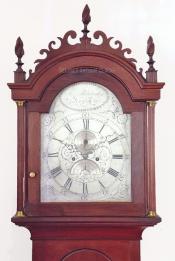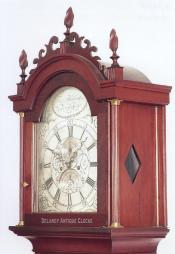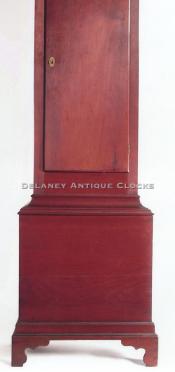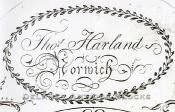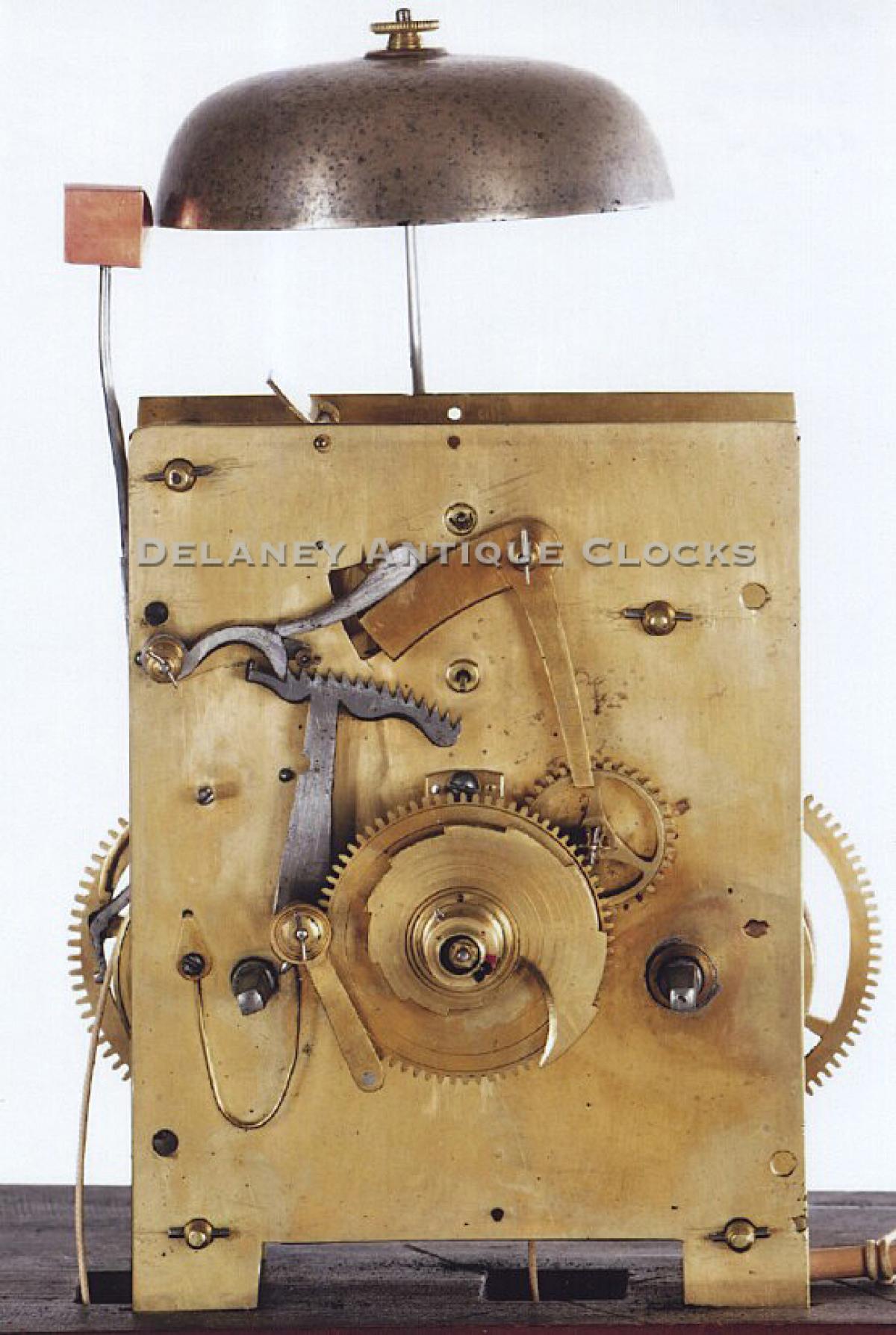Thomas Harland, Norwich, Connecticut. A fine Chippendale cherry cased tall clock featuring a case that is attributed to the cabinetmaker Felix Huntington. XXSL-14.
This case is of a distinctive type found on many of Thomas Harland’s tall case clocks. Among the cabinetmakers known to have provided cases to Harland are Abishai Woodward of Preston and Felix Huntington of Norwich. This signed Harland example is very similar in form to the Nathaniel Shipman and the Joseph Carpenter examples located in the collection at the Leffingwell Inn in Norwich. We believe these cases were also made by Huntington.
This clock stands on wonderful original Connecticut bracket feet applied to the double-stepped molding. The waist is long and narrow, centering a large tombstone-shaped waist door. This door is trimmed with a molded edge. The door provides access to the interior of the case. The pendulum and weights are accessible through this door. The hood rests on the upper cove molding. Fully turned and fluted hood columns are mounted in brass capitals. These flank the arched hood door and visually support the arched molding. This is surmounted with a whale’s tails fret and three fluted chimneys, each supporting a wonderfully carved flame finial. This clock stands 7 feet 8.5 inches tall overall.
The dial of this clock is representative of the types of dials he had made popular in Eastern Connecticut. It is composed of a single sheet of hammered flat brass. The surface is then decorated with several skillful engravings. The engraved chapter ring features Roman-style hour numerals and Arabic-style five-minute markers. The minute ring is closed. The rococo foliate spandrel designs are repeated in the center section of the dial. Also located here is the subsidiary seconds dial and oversized calendar aperture in the center. This dial is signed in the lunette in large script lettering. The signature reads, “Thos. Harland / Norwich.” All engraved work is filled with black wax or shellac, except the calendar and seconds displays. This area features engraved details that are filled with red. The dial is then treated with a silver wash. The silver wash does not adhere to the black or red colors, providing excellent contrast. The hands are finely cut from steel and have been blued. They stand out against the silver background to display the time.
This fine movement is constructed in brass and is of good quality. Four distinctively shaped turned pillars, “Cigar-shaped,” support the two large brass plates. These four posts are associated with the Harland / Burnap school of clockmaking. Hardened steel shafts support the polished steel pinions and brass gearing. The winding drums are grooved. The escapement is designed as a recoil format. The weight-driven movement is designed to run for eight days on a full wind. It is a two-train or a time-and-strike design, having a rack and snail striking system. As a result, it will strike each hour on the hour. This is done on a cast iron bell mounted above the movement. It is of excellent quality.
This clock was made circa 1780.
The case stands 7 feet 8.5 inches or 92.5 inches tall to the top of the center finial. It is 20.5 inches wide and 10 inches deep.
Inventory number XXSL-14.
Thomas Harland was an accomplished and influential clockmaker. He was responsible for training many clockmakers. Some of which became famous makers in their own right. He was the Simon Willard of Connecticut.
Thomas Harland was born in England in 1735. He emigrated to this country in 1773 through Boston on one of the infamous tea ships that later participated in Boston's Tea Party. He came to this country as a trained clockmaker and soon established a clock shop in Norwich. On December 9th of 1773, he advertised in the Norwich Packet: \"Thomas Harland, Watch and Clock-maker from London, Begs leave to acquaint the public that he has opened a shop near the store of Christopher Leffingwell, in Norwich where he makes in the neatest manner and on the most approved principles, horizontal, repeating and plain watches in gold, silver, metal or covered cases. Spring, musical and plain clocks; church clocks, regulators etc. He also cleans and repairs watches and clocks with the greatest care and dispatch, and upon reasonable terms. N.B. clock faces engraved and finished for the trade. Watch wheels and fuzees of all sorts and dimensions, cut and finished upon the shortest notice, neat as in London and at the same price.\" In the same year he married Hannah Clark. By 1790 he employed as many as twelve apprentices turning out an annual production of 40 clocks and 200 watches. Some of his more notable apprentices included the clockmakers Nathaniel Shipman, David Greenleaf, Gurdon Tracy, Jedediah Baldwin, William Cleveland, Daniel Burnap, Eli Terry, Seril & Ezra Dodge, Benjamin Hanks and his own son Thomas Jr., (1781-1806) to name just a few. Overall, he worked for thirty-five profitable years in America as a clockmaker, watchmaker, silversmith and engraver, probably producing more tall case clocks than any other Connecticut maker. He died at the age of 72 on March 31st, 1807. He is given credit as to making the first watch manufactured in this country.
Clocks that are known can be found in the collection of the Metropolitan Museum of Art, in the collection of the U. S. Department of State, in the collection of the Slater Memorial Museum in Norwich, Connecticut, in the collection of Wadsworth Atheneum, in the collection of The American Museum, Bath UK. Their are numerous examples pictured in various publications.


